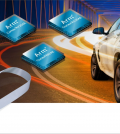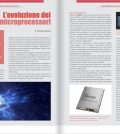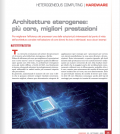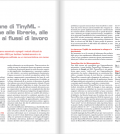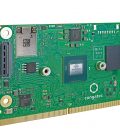2014 Outlook: Embedding Digital Processing in Analogue and Mixed-Signal Designs

Author: Richard York, Director of Embedded Processor Products at ARM
The market for analogue and mixed-signal semiconductors is set for some significant evolution over the next few years. The Internet of Things – in which billions of objects (smart or otherwise) will become IP enabled and connected – offers an abundance of opportunities for devices and systems that sense, control, actuate and communicate with the physical and most decidedly analogue world in which we live.
Another important trend that is uppermost in the collective mind of the entire electronics industry is delivering solutions that provide reduced power consumption and increased energy efficiency at the system level. Could the encroachment of digital processing technology into the esoteric field of analogue chip design provide an answer for each of these strategic trends?
Analogue design is of course the proverbial black art and combining it with digital is a highly complex process in advanced mixed-signal designs. Arguably though, it has become much easier in recent times. One important factor that has eased and sped up the development process is the growing sophistication of the mixed-signal design flow with EDA tools that now allow engineers to design and simulate both the analogue and digital in mixed-signal designs, while running C code simultaneously.
Previously, there have always been varying degrees of separation between the design and simulation of analogue and digital circuitry; and when it comes together in a single-chip layout, the design might not always work first time. But increasingly, thanks to these new advanced design tools, the process is now almost instantaneous, rather than taking many extra weeks in development. And when the increasing commercial availability of analogue IP along with digital libraries is added into the mix, this makes it significantly easier and quicker for any analogue or mixed-signal chip vendor to come up with fast and efficient designs in a way that that just was not possible a few years ago, and certainly for those without huge experience in this field.
Embedding Processing Capability
These advanced capabilities in the design flow make it increasingly easy to embed a digital processor into an analogue or mixed-signal design. There is no real penalty for example with the inclusion of a 32-bit Cortex-M0 processor core in a design. The core is implemented a minimum of only 12,000 logic gates and so it is virtually negligible in size compared to the surrounding analogue which is larger perhaps by a factor of 10:1; and therefore any additional cost for increased die area is correspondingly low.
Also the addition of a digital subsystem brings a significantly improved ability to test the device – a huge benefit that has not been fully recognized to date. A digital processor becomes a flexible engine that can be used to do all manner of on-chip tests and calibration in mixed-signal system-on-chip ICs, enabling much easier validation of the analogue electronics. Another advantage is increased system integration and therefore lower overall cost with the end system. The chances are a stand-alone microcontroller is already used in a customer design alongside an analogue or mixed-signal chip.
An analogue chip vendor is now in a much better position to offer a greater level of integration. Of course, this may or may not actually happen: some vendors may wish to use the digital processor for on-chip testability for example and not necessarily open it up to customers for further feature development. But overall, this is a very clear value proposition for an analogue chip vendor. And on the other side of the equation, leading digital vendors are seeking to augment their digital processing portfolio with analogue components.
Improving Energy Efficiency of the System
While this new and emerging generation of mixed-signal devices has the capability to fulfil the requirements of the Internet of Things, the big point to make is that embedding a digital processor will significantly improve the efficiency and performance of the system overall, representing huge savings in power consumption.
So what can digital do to enhance the capabilities of analogue components to improve system power consumption? One specific and very important example is in motor control, where very clearly power electronics and the analogue are absolutely crucial. A digital processor can enable significantly better motor management of speed and/or rotation, delivering a potential saving in power consumption of around 40 per cent. And the motors in this example are large motors in industrial applications, not necessarily low-cost consumables such as toys. The digital does not replace or take anything away from the analogue – it simply enables digital control to improve the quality of the overall system.
So, with these advanced capabilities, in conjunction with the increased integration possibilities and higher levels of on-chip functionality, the return on investment can be very fast with the inclusion of a small and powerful digital processor core. The corroboration of all this is that analogue and mixed-signal devices that embed digital processing capabilities are now coming on to the market. One example is a mixed-signal processor from Analog Devices: the ADSP-CMX40X includes a Cortex-M4 processor and enables motor drive developers to add more features into the silicon.
The device specifically targets energy-efficient applications in industrial markets and is designed to deliver more precise motor control in motor drives, photovoltaic inverters and closed-loop servo control. A second instance is Infineon’s XMC4000 family: also embedding a Cortex-M4, this device is also aimed at improving energy efficiency in industrial applications. And a third is the recent licensing by Dialog Semiconductor of the Cortex-M0 processor, which the company plans to use as the controller in a range of power management ICs for power control and battery management functions in smart phones or tablets.
Future
In a few year’s time, or even sooner, it could be that the vast majority or at least a high percentage of analogue and mixed-signal chip designs will integrate a high-performance digital processing subsystem to control and manage it, and also enable developers to add their own software code on top. The key applications are likely to be in motor control and power electronics, and today the vast majority of these applications are essentially ‘dumb’. Endowing them with digital intelligence, in the case of motors, could potentially save enormous amounts of energy. One estimate posited recently is that electric motors consume 40 per cent of the world’s electrical energy and much of that is in industrial motor drives. So, a little digital treatment of analogue could slash this footprint enabling significant environmental and cost benefits.
In the coming years as the Internet of Things becomes a larger reality and the demand for reduced power consumption heightens, the model for the next-generation of sophisticated analogue and mixed-signal circuits, is likely to combine ‘analogue on the edge’ to sense and actuate with ‘digital at the heart’ to control, make decisions and communicate. A highly integrated and digitally controlled analogue system-on-chip that has the potential to save 40 per cent of the energy consumption of an industrial motor, whether its from an analogue or a digital semiconductor vendor, is an extremely compelling technology that has every reason to be in much demand in the very near future.
Read the complete 2014 Outlook on EONews 570
Contenuti correlati
-
eMCOS POSIX di eSOL supporta il processore automotive Arm Cortex-R82AE
eSOL ha annunciato il supporto per il processore per il mercato automotive Arm Cortex-R82AE tramite il suo sistema operativo eMCOS POSIX. Questo risultato è stato reso possibile utilizzando prototipi virtuali dell’IP di Arm sotto Arm Virtual Hardware...
-
Come aumentare la sicurezza delle comunicazioni nei sistemi di ricarica dei veicoli elettrici
Nel caso dei veicoli elettrici, è possibile sfruttare diversi punti di attacco: uno che desta una crescente preoccupazione è l’infrastruttura di ricarica Leggi l’articolo completo su EO Power 34
-
Lauterbach supporta debug e tracciamento per le nuove CPU automotive Arm
Lauterbach ha annunciato il supporto da parte dei suoi strumenti TRACE32 delle CPU Automotive Enhanced (AE) di Arm. Si tratta dei processori di nuova generazione, basati su Armv9, Arm Neoverse-V3AE, Cortex-A720AE, Cortex-A520AE e Cortex-R82AE. Il supporto da...
-
Siemens e Arm: ambiente di simulazione pre-silicio per Arm Cortex-A720 AE
Siemens Digital Industries Software e Arm mostreranno il primo ambiente di simulazione pre-silicio per Arm Cortex-A720 AE per i Software Defined Vehicles (SVD). La nuova soluzione costituisce il primo ambiente di simulazione accelerata in grado di supportare...
-
Socionext annuncia la collaborazione con Arm e TSMC
Socionext ha annunciato una collaborazione con Arm e TSMC per lo sviluppo di un innovativo chiplet con CPU a 32 core ottimizzato dal punto di vista energetico e realizzato con la tecnologia da 2 nm di TSMC....
-
Lauterbach: supporto per i processori Arm della prossima generazione
Lauterbach ha annunciato il supporto, tramite TRACE32, dei più recenti processori Arm v9.2. Si tratta dei processori di prossima generazione Cortex-X4, Cortex-A720 e Cortex-A520 e il supporto di TRACE32 comprende comprende il debug simultaneo dei core eterogenei...
-
L’evoluzione dei microprocessori
L’offerta di processori negli ultimi anni è notevolmente aumentata e si è differenziata sensibilmente grazie alle diverse architetture che si sono evolute. Il mondo dei microprocessori x86 resta comunque uno dei più dinamici visti anche gli enormi...
-
Architetture eterogenee: più core, migliori prestazioni
Per migliorare l’efficienza dei processori una delle soluzioni più interessanti dal punto di vista dell’architettura consiste nell’adozione di core diversi fra loro e ottimizzati: ecco alcuni esempi Leggi l’articolo completo su Embedded 85
-
Implementazione di TinyML – un’introduzione alle librerie, alle piattaforme e ai flussi di lavoro (2a parte)
Nel secondo articolo di questa serie verranno esaminati e spiegati i metodi utilizzati da TensorFlow Lite, Edge Impulse e Fraunhofer AIfES per facilitare l’addestramento e la distribuzione di un modello basato sull’intelligenza artificiale su un microcontrollore con...
-
I moduli di congatec hanno ottenuto la certificazione ARM SystemReady IR
I moduli COM di congatec, in formato SMARC basati sui processori della linea i.MX 8M di NXP, hanno ottenuto la certificazione SystemReady IR nell’ambito del progetto Cassini promosso da ARM. Il progetto Cassini ha come obiettivo la...




